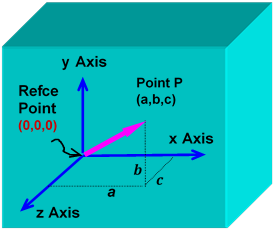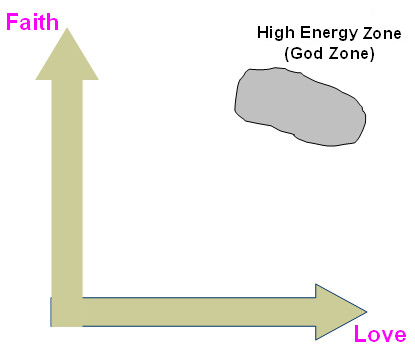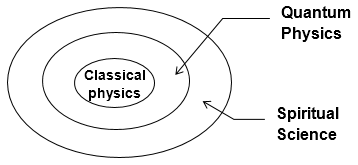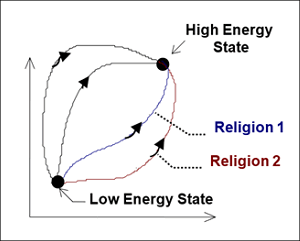| Copyright © 2018-2024 Prem Kamble | ||||||||||||||||||||||||||||||||||||||||||||||||||||||||||||||||||||||||||||||||||||||||||||||||||||
|
Prem Spirituality Model™ - Spiritualily for the Common Man thru a Spiritual Revolution |
||||||||||||||||||||||||||||||||||||||||||||||||||||||||||||||||||||||||||||||||||||||||||||||||||||
| Related Articles || Published in Journals || Podcast Video || Podcast Transcript | ||||||||||||||||||||||||||||||||||||||||||||||||||||||||||||||||||||||||||||||||||||||||||||||||||||
|
This article is an updated version of my paper, which was presented at the 8th International Conference on "Sustainable and Human Development Through Spirituality, Peace Economics and Peace Science" on 6th April, 2018 at Bangalore, India. The paper has been published in International Journal of Exclusive Management Research, June 2018 (paper is downloadable
here). While this article provides a comprehensive overview of the Prem Spirituality ModelTM in details, a brief introduction of the paper is also available
here
1. Introduction1.1 Introduction
Prem Spirituality Model™ aims to provide a simple definition of
Spirituality with a scientific flavor
The world is currently plagued by widespread hatred and violence. In my view, spirituality offers a solution to global human problems. The focus of my paper is on global peace, human development and sustainability through spirituality. Human development can only occur when the world and all humans living in it are at peace. Human beings are at peace when the mind is at peace. I consider Spirituality as a potential solution because spirituality is directly linked with human mind and human ability to use the power of the mind. The Industrial Revolution empowered the common man with muscle power, while the information revolution provided brain power. The next significant revolution - The Spiritual Revolution is poised to make mind-power readily accessible to the common man, although its exact timing remains uncertain. It could take 50 years, or even 500 years. Therefore, we must explore ways to expedite its arrival. This paper proposes two strategies to facilitate an early realisation of the Spiritual revolution: • We need a more scientific yet simple definition of spirituality that can be understood by the general public • We need a more scientific approach to research on spirituality The paper aims to contribute in both of these area by suggesting a straightforward definition of spirituality and by constructing a model which can facilitate more scientific research on the subject. It does not criticize any religion nor opposes religion. Instead, it encourages individuals to follow their respective own religions without bias towards others, enabling them to benefit from their own faiths, while avoiding the negative consequences of excessive devotion. 1.2 Current Understanding of Spirituality
Spirituality is a science which relates to you and your mind alone. It has nothing to do with the concept of religion or god”
Let me start with our current vague understanding of Spirituality. We say that Buddha and several other ancient saints were highly spiritual. Let us try to analyse what was meant when we say Buddha had reached a very spiritual state. The spiritual state of prophets and sages like Buddha was characterised by the following three attributes: 1. Compassionate: They were extremely high on love and compassion, possibly on all the positive feelings. They were in a state of extreme benevolence with no ill feelings. 2. Powerful: They were extremely powerful individuals. They had complete control over their mind and were able to use their "Mind Power". They had high "mental energy". 3. Enlightened: They were said to be enlightened. They had an extremely powerful transcendental experience which is difficult to express, and is sometimes referred to as having seen Ultimate Reality, or experienced God. This experience gave them immense wisdom and perhaps great insights into worldly affairs. Let me call this state of mind as "God State" (explained later) for ease of discussion. We will build a "scientific" model, which I call Prem Spirituality ModelTM (Prem means Love!), to look at these three characteristics and try to derive a more scientific definition to the phenomenon of spirituality. We will examine and understand each of these attributes of spirituality, including "Enlightenment", and see how they fit into our "scientific" model. The word "Scientific" is used within quotes as the model is based on not only the known science, but also the yet-unknown possible future science. In fact, the present science is not adequate to explain the spiritual phenomena and completely new scientific methods may need to be developed. 2. Need for a New "Science"2.1 Physical Science & Mathematics Fail to Explain Spirituality - Need for a New "Science"
The Industrial Revolution gave us muscle power and the information revolution gave brain power. The Spiritual Revolution will provide us with mind power
Prem Spirituality Model™ envisions the emergence of an entirely novel "science" termed "spiritual science" and a groundbreaking language, Mentomatics, designed to articulate the universal laws governing spiritual phenomena. This marks a significant evolution beyond the Classical Model and Quantum Model in the realm of science, paving the way for what is termed the "Spiritual" Model. The model presented here serves as a prelude to the exploration of this nascent spiritual science and offers insights into Mentomatics. When fully developed, Mentomatics has the potential to unravel the laws governing the spiritual world, which is as intrinsic to our universe as the laws governing the physical world. This model draws an analogy with the historical development of Mathematics and physical science to envision a future where Mentomatics and "spiritual science" play a similar role in understanding and exploring spirituality and the unknown world of the human mind. It provides a visionary perspective on what forthcoming scientific developments might resemble when we extrapolate past advancements in the realm of the physical world and apply them to the enigmatic domain of the human mind. It emphasizes the need for a new scientific approach to spirituality that can complement and expand upon our existing knowledge. The model also illustrates how spirituality can be completely dissociated from the realm of religion and be researched as a pure science. Given the current state of affairs, it would be impractical to expect significant breakthroughs. Nevertheless, this paper can fulfil its purpose if, drawing from this analogy, the model serves as a catalyst for further scientific research into spirituality, guiding us to realize the dream of a Spiritual Revolution. As we will be employing some very basic concepts of physics, it would be beneficial to revisit certain elementary physics principles, which will be no more intricate than those encountered in school physics. There is no need to be overwhelmed by the diagrams, which might appear somewhat mathematical. If you are acquainted with the basics of 3-Dimensional Physical space, you can readily skip the following section. 2.2 Refresher of Simple School Physics - The Physical 3-Dimensional Space
Feel free to skip this section if you recall your lessons from school physics. In the physical realm, we perceive a three-dimensional space (refer to Fig. 2.1), where each object occupies a distinct position. We use the coordinates x, y, and z to measure distances in the three dimensions or directions from the Point of Origin (Reference Point represented by coordinates (0,0,0) in Fig. 2.1). The physical position of an object in this space is indicated by its x, y, and z co-ordinates. For instance, in Fig. 2.1, if an object is located at point P, its position is specified by co-ordinates a, b and c respectively. Therefore, Fig. 2.1 represents the familiar physical space.
It is widely acknowledged that every object in the Physical Space possesses potential energy. The amount of potential energy depends on the object's position within the three-dimensional space, as indicated by the x, y, and z axes. In Fig. 2.2, an object situated at point P2 has a higher potential energy than an object at point P1.
These are all the basic scientific concepts that we will use in this paper. 3. Prem Spirituality Model™ - Definition3.1 Physical Space and Mental Space
Prem Spirituality ModelTM
will move spirituality from the locked doors of temples
and faith based religions to universities and research labs.
It paves the way to a scientific study of spiritual world
Reflecting on this experience may raise several questions: How did you summon the energy to move from a state of despondency to one of empowerment with just a few uplifting words? Where did this newfound energy originate? Was it dormant within you, waiting to be activated? All that we can affirm is that a transformation occurred in the state of your mind. Initially, you were in a mental state associated with very low energy, and subsequently, you shifted to a state resulting in significantly elevated energy. Nothing in the external circumstances appears to have changed. It becomes evident that this phenomenon pertains to some mysterious phenomenon of the mind. As the energy was internally generated due to a shift in mindset, we refer to this energy as mental energy in the maintal domain, similar to energies such as the potential energy applicable in the physical domain (Fig. 2.2). Analogous to the low and high potential energy depicted in Fig. 2.2, you moved from a low mental energy to high energy. . Drawing upon fundamental knowledge from physical science, if we were to graph your energy states before and after receiving words of encouragement, the depiction might resemble what is presented in Fig. 3. The graph broadly illustrates the low energy level (L) before the encouraging words and the high energy level (H) afterward. If the domain in Fig. 2.2 was called the physical space, we call the domain in Fig. 3 as the mental or spiritual space.
Point L signifies your position in the mental space before the uplifting words, representing a low mental and energy state. Point H symbolizes your position afterward, characterized by elevated mental state and energy. Note that the axes of the mental space are yet undetermined and are marked with red question mark ('?'). If P1 and P2 denoted positions of low and high potential energy in our familiar physical space (Fig. 2.2), points L and H represent the poistions of low and high mental energy in the mental space P1 and P2 denoted positions of low and high potential energy. Just as we occupy different positions in the physical space, apparently, we simultaneously occupy positions in the mental space too with varying energy levels. While the axes in physical space represented distances in x, y, and z directions, the three axes here are denoted with a red '?' to signify our current lack of knowledge regarding the axes of the mental space. Let's attempt to define these axes. 3.2 What are axes of Mental Space?
Laws of physical science apply to the physical space and are fairly well
explained by Mathematics. Spiritual Space too is governed by yet-unknown
laws of spiritual science
Upon close analysis, it becomes evident that that there indeed was a change that transpired within you - in your state of mind. The transformative words shifted you from a state of hopelessness to one marked by hope and determination. The catalyst for this shift in the "mental state" was your feelings. The feelings of fear and despair gave way to hope, confidence, and courage. You had more faith in yourself. In essence, if feelings were measurable, you registered low on certain feelings at position L and high on those at H. Hence, the axes of the mental space are identified as your feelings. In Fig. 4, we illustrate a schematic representation of Mental Space with three pivotal feelings as axes: Love, Faith, and Hope. Point L denotes your position in the mental space before hearing the encouraging words, while Point H signifies your position afterward. Point L corresponds to a low mental and energy state, whereas Point H signifies high levels on both fronts.
Only three essential feelings are considered in plotting the mental space (Fig. 4) for simplicity and ease of comparison with our familiar 3-dimensional physical space. However, our mental state depends not only on these three feelings but on multiple feelings and emotions, as detailed in Table 1:
Table 1: Positive and Negative set of feelings Since there are numerous feelings, the mental space becomes a multi-dimensional space, which may look something as depicted in Fig. 5. Each line represents a feeling, with one side from the centre indicating positive measures and the other negative measures. For example, hope on one side and despair on the opposite side are depicted on a single axis as the positive and negative measures respectively of one set of feelings. However, for simplicity, we work with the three-dimensional mental space shown in Fig. 6.2, enabling a comparison with the familiar physical space (Fig 6.1).
Today, it is not possible to measure feelings just as there was a time when distances were immeasurable. However, contemporary advancements enable us to measure not only physical distances but also intangible entities like light, sound, wavelengths, etc - something once considered unthinkable. Therefore, it is plausible that there will come a time when intangibles like feelings can also be measured, enabling us to precisely plot our position in the mental space. 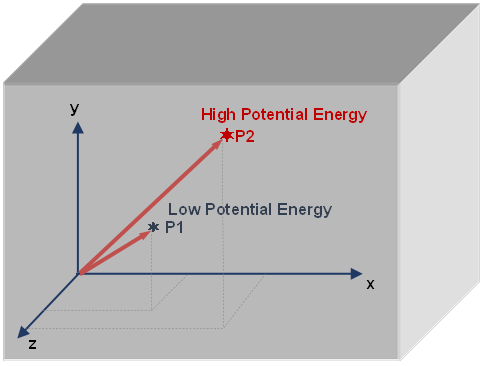 Fig. 6.1: Physical Space
Fig. 6.1: Physical Space
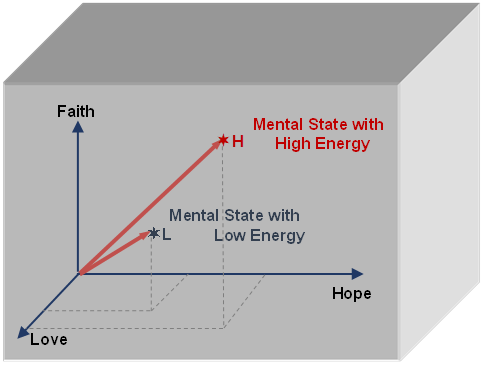 Fig. 6.2: Mental/Spiritual Space
Fig. 6.2: Mental/Spiritual Space
Fig. 6: Prem Spirituality Model
This concludes our conceptualization of "Prem Spirituality ModelTM" (Fig. 6). The model includes the familiar Physical space with x,y,z coordinates, and a similar mental or spiritual space, the dimensions of which are defined by our various feelings such as love, fear, hope, faith, courage, and more. Analogous to our position in the physical space, we also occupy a unique position in the mental space at any given time. To further understand how this model can explain spirituality, spiritual states and spiritual energy, we need to delve deeper in this model. 3.3 Physical State and Mental State
Similar to how a point in the three-dimensional physical space denotes the physical position of a body in that space, a point in the mental space represents a specific state of mind or mental state. My position in the mental space and my mental state can be defined by the extent to which I measure on the feelings-axes at that moment. Conversely, how I measure on the different feelings axes at any given time determines my position in the mental space and my mental state.
4. Prem Spirituality Model - Implications4.1 Physical Energy and Mental Energy
It is evident that a change in your mental state, triggered by hearing the magic words, was immediately followed by a change in your energy state. You transitioned from a "low energy state" to a very "high energy state". Your negative feelings, as listed in Table 1, transformed into positive ones after hearing words of encouragement. It appears that we possess an inherent power that lies dormant within us but can be activated. Since the energy does not seem to have come from an external source , it implies that the energy was dormant within you in one state of mind and suddenly became active in another state.
4.2 Prem Spirituality Model - God State and God Zones
Spirituality is a science which relates to you and your mind alone.
It has nothing to do with the concept of religion or god
What is commonly known as reaching god or attaining god is synonymous with reaching these high energy states in the mental space (Fig. 7). Therefore, we term this state of mind with extremely high mental energy as "God State". The zones in the mental space corresponding to such highly positive feelings and high mental energy are called "God zones"
Isn't this the same "God State" described right in the beginning in Section 1.2, "Current Understanding of Spirituality"? We stated that a high spiritual state is characterised by three characteristics - Compassion, Power and Enlightenment. This definition aligns well with our "mathematical" representation in Fig. 7, as the God State is indeed characterised by high positive feelings (compassionate) and high mental energy (powerful). It is a highly spiritual and powerful state of mind. God Zones are areas where the measures of confidence, love, faith, hope, etc. are extremely high.
5. What is Spirituality?
Spirituality, then, is simply reaching the god zones in the mental space, or in other words, reaching a state of mind with highly positive feelings. Two attributes of our spiritual state, specifically being Powerful and compassionate harmoniously align with our Prem Spirituality Model (Fig. 7). 'Prem' translates to love in several Indian languages, and love is the most crucial component of spirituality. This is precisely why the model is named as 'Prem Spirituality Model'. We will later discover that the third characteristic, namely Enlightenment, also integrates seamlessly with our model, as depicted in Fig. 7. But before delving into that, let us take a moment to contemplate if we are truly grasping the essence of the word "spirituality".
6. What is Enlightenment?6.1 Common Meaning of Enlightenment
Enlightenment commonly refers to an "aha moment", a juncture when you suddenly gain complete clarity on something that you have always seen or heard but could not fully grasp. It is comparable to discovering an object on your office table or room that has always been there, yet you never took notice of it. It is like a sudden awakening or insight.
6.2 Physical Laws of Universe: Known and Proven
We know that the physical space illustrated in Fig 8.1 adheres to established physical laws of universe, such as gravitational law, laws of forces and principles of action and reaction. These laws have been fairly well understood and explained. We can gauge physical distances along x,y,z axes, assign numerical values to positions in the physical space, measure the strength of physical forces and the potential energy. In essence, aided by physical science and mathematics, we know precisely the magnitude of force and the exact angle (φ) required to propel an object from point A to point B in physical space (Fig 8.1).
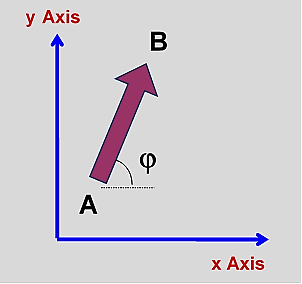 Fig. 8.1: In Physical Space, Physics & Maths inform us what force and angle (φ) are required to move from A to B
Fig. 8.1: In Physical Space, Physics & Maths inform us what force and angle (φ) are required to move from A to B
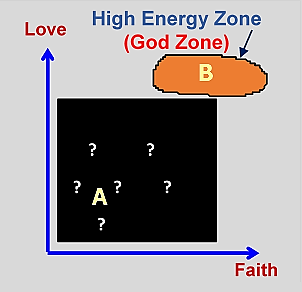 Fig. 8.2: In the Mental Space, we are in the dark about how to move from a low energy position A to high energy position B
Fig. 8.2: In the Mental Space, we are in the dark about how to move from a low energy position A to high energy position B
Fig. 8: Forces in Physical Space and Mental Space
6.3 Spiritual Laws of the Universe: Yet-Unknown
Indeed, this spiritual space too possesses its own set of laws. What are these laws?
6.4 What are the Spiritual Laws of the Universe?
Indeed, the realm of spirituality is governed by its own set of laws. Through scientific exploration of spirituality, we will discover that just as the physical world operates under universal laws of physical science, the realm of the mind is also subject to common and universal laws of spiritual science. These laws are interpreted and expressed in various ways by different religions, often leading to divisions. In their purest form, the teachings of religions embody these universal laws of the spiritual realm. For example, a verse from the Hindu scripture Bhagavad Gita states, "Do your duty without expecting the fruits of your work." The original Sanskrit verse can be roughly translated as:
6.5 Why Do We Lack Trust in the Spiritual Laws?
Today, we find it difficult to believe in the laws of the spiritual realm because, more often than not, they appear ineffective. It is not that the laws themselves are incorrect, but rather that we practice them with incomplete knowledge due to limited or no advances in spiritual science. Unlike the field of physical science, where mathematical formulas and controlled parameters ensure precise outcomes, our efforts in the spiritual realms often feel like shots in the dark.
Prem provides a new vision of spiritually-evolved human beings
and a violence-free world, and suggests new areas of research
in mind-science to realize the vision
Why was Buddha able to reach God zones that many others could not? Did Buddha possess knowledge of certain rules of the spiritual space that others were unaware of? When Buddha attained enlightenment, why was he able to perceive and experience things that others could not? The spiritual law "Good begets good" may not always yield the desired results, depending on the depth of your feelings and your state of mind or position in the spiritual realm at the time of performing the deed. Did you perform the action with a feeling of love or with expectations? How intense were your emotions? It is possible that such parameters affect the outcome. We simply do not comprehend the laws of this realm, nor can we measure any of its parameters. As a result, we find ourselves groping in the dark. Some individuals may learn to practise these laws by chance, while others learn through methods such as meditation and mind control. However, even those who have learned to practise these laws often struggle to explain them, as there is no language to express them adequately. There is no formal, quick, and precise way to explain, learn, and practise these laws with repeatable accuracy, as we have for physical laws using mathematics and physics. 6.6 What is Enlightenment?
The universe consists of not only the physical space we are so familiar with,
but also a spiritual space. All of us occupy a certain position in this space,
just like we do in a physical space
Based on our previous discussion of the spiritual model, the God state, and the exceptional abilities of those who have attained it, it is apparent that these insights could only have been acquired through an understanding of the laws governing the spiritual realm. In our "scientific" model, we can therefore posit that enlightenment is a state of mind in which an individual in the God state gains complete insight into the unknown laws of the spiritual realm. When we say they had a glimpse into the Ultimate Reality, we mean they had a glimpse into the Spiritual Laws of the Universe. They possessed profound understanding of both the physical and spiritual laws that govern the universe. They had a deep clarity regarding these laws and could put them into practice. The saints, through meditation or deep introspection, were able to develop new mental faculties that allowed them to recognize, understand, and even practically exploit the laws of the mind. Is it likely that our brain has some quantum properties, and the spiritual saints, through meditation or other means, developed their faculties to access these properties? It is possible that, in their enlightened state, the ancient spiritual sages had special insights into both the physical laws of the physical realm and the spiritual laws of the mental realm. How else could they create Yoga, discover the medicinal and nutritional values of plants, and gain insights into astrology and astronomy without the sophisticated tools available to us today? It is said that Buddha identified that all matter is composed of tiny particles called kalapas. (For more information, you can search for 'Kalapas' on the internet.) This indicates that the state of mind they reached endowed them with special abilities to perceive what is invisible to the average person. They developed expertise in utilizing and practicing the spiritual laws of the universe, which bestowed upon them powers that some might call supernatural. 6.7 Supernatural versus Spiritual Laws of Universe
Our model reveals that these abilities are not truly supernatural; they are instead governed by the natural spiritual laws of the universe, much like the physical laws that govern our physical world. These so-called supernatural abilities are accessible to every human being capable of reaching the god zone or a state of enlightenment, but most of us are unaware of how to attain such a state. Everything that occurs is governed by the natural laws of the universe, either the physical laws or spiritual laws of nature. There is nothing transcendent or supernatural about it. Each one of us has the potential to reach this enlightened state of mind, each one of us can become a Buddha. Buddha, after all, was an ordinary human being like the rest of us before he attained enlightenment. What is needed is a modern method, suited for our fast-paced world, to achieve this state of mind.
Spiritual Revolution will bring all religions under one umbrella of spirituality,
with common 'scientifically' explained and 'repeatable-in-labs' Laws of Spiritual
Science
It cannot be established whether the enlightened sages knew the underlying theory. In other words, they may have been practitioners of these laws, not theorists. It is similar to learning how to use a machine or computer through trial, observation, and practice, without fully comprehending its inner workings. In ancient times, people used the stars, sun, winds, and tides for navigation without understanding the underlying scientific principles. Similarly, a pilot learns to fly an aircraft without fully understanding the scientific principles that enable flight. Even if they knew the theory, they could not explain it to the common person in the absence of a suitable language of Mentomatics (even mathematics had not yet been developed). Although they may have comprehended these laws, they lacked the language and vocabulary to explain them. 7. Mentomatics7.1 Mathematics: Explaining the Laws of Physical Space
The field of study known as Physical Science provided clarity in understanding the laws governing the physical realm. However, it was Mathematics that truly enabled us to explain and document these laws. Mathematics provided us a precise language to express how to move an object from point A to point B in physical space with total precision (Fig. 8.1). Prior to the discovery of Mathematics, humanity remained completely ignorant of the laws governing physical space. The discovery of Mathematics marked a critical milestone that transformed the history of physical science. It emerged as a powerful force that propelled the growth of physical sciences to unprecedented heights, liberating humanity from an era of ignorance and ushering in the age of scientific revolution. Mathematics not only accurately explained the physical nature of the universe but also helped predict some effects. With the advent of calculus, the remaining unexplained phenomena related to physical forces in the universe were elucidated.
7.2 Mentomatics: Unveiling the Laws of Mental Space
The language of Mathematics fails to adequately explain the phenomena of the spiritual realm. We require a new language capable of elucidating and expressing the laws that govern the spiritual space.
7.3 Mentomatics - The Key to the Spiritual Revolution
The key to advancing spiritual science lies in Mentomatics. If we can develop Mentomatics, perhaps as an upgraded version of mathematics and calculus, we will unravel the mysteries of the spiritual realm. In this realm, there will be no religion or gods - only verified universal principles of spiritual science.
But what is the key to developing Mentomatics?
As spiritual science progresses, the expectation is that all religions will eventually converge into a single set of universal spiritual laws. Even if this unity is not fully achieved, at the very least, the futility of discriminating between religions will become evident, fostering greater tolerance for diverse religious beliefs. 8. Prem Spirituality Model and World Peace
How does the model contribute to global peace? It does so in two significant ways.
9. The Way Forward9.1 Summary of "Prem Model of Spirituality" & The Path AheadLet us summarise the key points of our model. The model helps us define spirituality and to suggest a way forward towards realising the Spiritual Revolution. The universe consists not only of the physical space we know well, but also a spiritual space. Just as we occupy a certain position in physical space, we also have a position in this spiritual space. 9.2 Skepticism, Criticism of "Prem Spirituality Model" & Further Reading
Due to the limitations of scope and time in this paper, I understand that many questions remain unanswered. This paper may raise doubts in the minds of cynics and skeptics regarding its feasibility. It is not possible to address all doubts in this paper. Instead, this paper focuses on using the Prem Spirituality Model to define spirituality, explain the potential meaning of enlightenment, and introduce the concept of Mentomatics.
Copyright © 2018-24 Prem Kamble
eJournals where this article has been published
This article has been published as an academic paper in the following eJournals/Issues. You may need to login to ssrn.com site to view details of these journals. At this link at ssrn site, however, you can read the abstract of the paper and also download a pdf copy of the article. You do not need to log in to do so.
|

